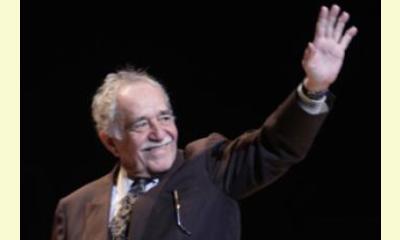|
|
Gabriel García Márquez and the peace process in Colombia
un articulo por David Adams, CPNN Coordinator
The passing of the great Colombian writer, Gabriel García Márquez, is being seen by all sides of the conflict in that country as an inspiration to complete the peace process and arrive at a Colombia in peace.

Photo of Gabriel García Márquez from Tusmedios
click on photo to enlarge
The President of the Republic, Juan Manuel Santos Calderón, said the following as he officiated at the ceremony at the Cathedral of Bogota in memory of the writer who died in Mexico on Thursday 17 April:
"Today we gather in this First Cathedral in the Plaza de Bolivar in our capital , through the media, to pay the tribute of our affection. Gabriel García Márquez sought peace, he worked for peace, he always wanted a Colombia in peace and, in his memory, we will not falter in this task, the greatest task we have as a nation."
On the other side of the conflict, The Revolutionary Armed Forces of Colombia (FARC ) rebels said that with his departure "Colombia loses and the whole world loses." They announced that they will "make peace" as Gabriel García Márquez always wanted. "With the farewell of this magnificent man, we reiterate in the words of Aureliano Buendia that we will make the dream of peace, a quiet country where we can make fish from gold without destroying our environment." Aureliano Buendia is a main character in the great novel of Marquez, One Hundred Years of Solitude.
Meanwhile, the Congress of Colombia said that "the signing of a peace agreement between the government and the FARC is the best tribute we can give the writer Gabriel García Márquez."
Senate President Juan Fernando Cristo, said that Márquez, who won the 1982 Nobel Prize for Literature, was a " tireless advocate" for peace in his country, so that a solution to half a century of war in Colombia , would be the best tribute to his memory. "He rendered great service to the country in the search for a negotiated solution to the conflict, but he left us before he could see a Colombia in peace. Hopefully this year Colombians will give him the best tribute by achieving peace,"
|








|
DISCUSSION
Pregunta(s) relacionada(s) al artículo :
What is happening in Colombia, Is peace possible?
* * * * *
Comentario más reciente:
The force of non-violence constrains the force of arms!
Colombia - the force of peaceful resistance -
At the beginning of July, the rebels of the armed revolutionary forces of Colombia (FARC) kidnapped a 51 year old Swiss, and his Colombian assistant who worked in the Indian communities of Cauca province where they were setting up development projects by building schools and community production enterprises.
The news of the kidnapping was spread through all the villages and 2000 Indians set out to pursue the 400 guerillas. They reached them at an elevation of over 4000 meters (12,000 feet), encircled them, and without any weapon, constrained them to release the 2 hostages! (After 2 days, the hostages were released).
This release, obtained through "peaceful resistance" has raised a national debate: the possibility of resisting violence without needing to use weapons has demonstrated the effectiveness of human solidarity movements.
"I will return, and I will then be millions" prophesied the Aymara Indian leader Tapak Katari, in 1781, at the time of his execution by the Spanish conquistadors.
100 million in 1492, the Indians were no more than 4,5 million one century and half later. Currently there are 44 million Indians populating Latin America.
In spite of their great diversity, the Indian movements take on more and more importance. In Ecuador, Guatemala, Bolivia, Peru, Mexico or Colombie they are opposed to the neoliberal system that governs the Americas, while protesting against the imposition of the American economic market. . ... continuación.

|
|









